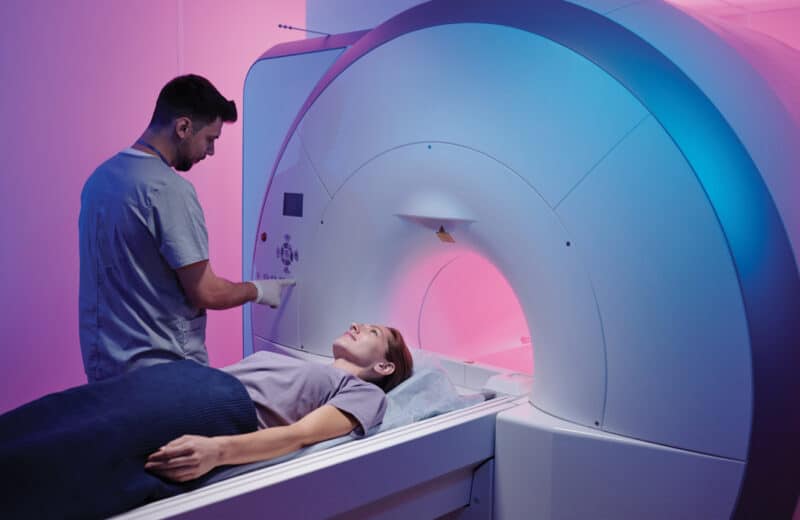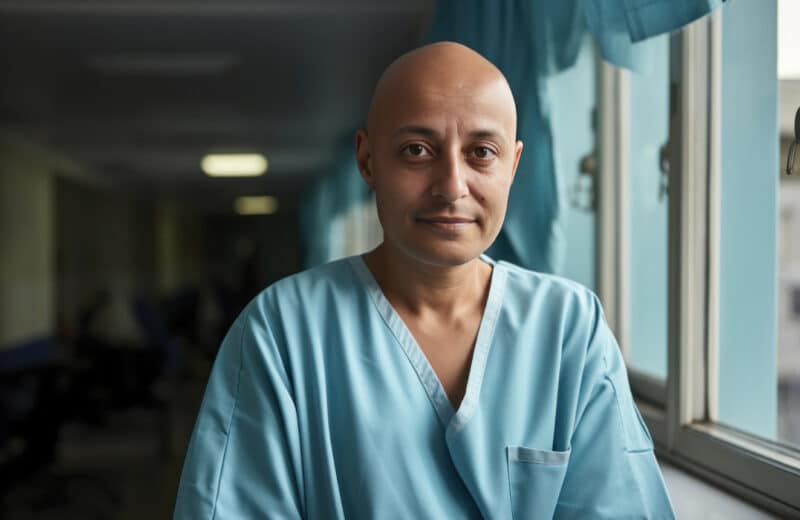A bionic leg increases mobility by responding to brain power
Fact checked by Shannon Sparks
Stephen Littig had to have his left leg amputated above the knee when he was 65. Afterward, he went to the Shirley Ryan AbilityLab for rehabilitation. The goal: to increase his strength enough to use a prosthetic leg — and then learn how to live the rest of his life with it.
In the U.S., some 150,000 people have lower limb amputations every year as a result of diabetes mellitus, peripheral vascular disease, neuropathy, or trauma due to accidents and combat casualties.
Levi Hargrove, PhD, the scientific chair of the Regenstein Foundation Center for Bionic Medicine at the Shirley Ryan AbilityLab, says that although helpful, there are drawbacks to typical prostheses. “That prosthesis is like a stiff walking stick on the end of a spring, so people bounce along when they walk. It is very difficult for many people to walk up and down stairs or a slope, to sit down and stand up,” he says. The person has to use their hip to move the prosthesis and to rely on their existing leg to stabilize themselves, which can be tiring.
About a year and a half ago, the AbilityLab reached out to Littig, who lives in Lake Geneva, Wisconsin, to invite him to participate in research on a bionic leg that Hargrove and his team were developing. In 2008, Hargrove’s team, encouraged by their previous work on a bionic arm, started developing a thought-controlled bionic leg that allows the knee and ankle to bend and the foot to emulate natural foot movements.
Littig signed up immediately.
How the technology works
The bionic leg’s engineering was possible because of emerging miniature sensors that can detect signals that measure what the body is doing. The person simply has to think about moving the bionic leg, and it responds.
Nerves instruct the residual leg muscles remaining after the amputation to contract. Electrodes placed over the muscles detect the contractions that indicate the movement the person wants to make. These small electric signals, called electromyographic (EMG) signals, are sent to a computer that decodes the patterns of the movement and sends commands to the motorized knee and ankle, which execute the desired coordinated movements.
“The movement of the leg is seamless and intuitive,” Hargrove says.
It took around two years to develop a prototype of the bionic leg. “At the beginning it was complicated and it didn’t work very well, but then we finally got it operating the way we thought it should,” Hargrove says.
He remembers one participant whose face lit up when he tried the leg. “Now I know what you’re trying to do for me,” Hargrove recalls the participant saying. “That was a very rewarding and enlightening moment for the entire team because we finally got it to a point where it was helping him.”
By now, around 50 participants have tried the bionic leg. They range in age from age 25 to 78. Some of them, including a Paralympian, are extremely active, while others face mobility challenges. Three patients have taken a bionic leg home for a few days.
Those who have tried the bionic leg describe a dramatic difference.
“Some participants in the study say that walking with their own prosthesis is like walking in a ski boot that is heavy and cumbersome because the ankle can’t move, and the bionic leg is like walking without one. In general, our research subjects have observed that the leg feels like an extension of their body, enabling them to get around seamlessly,” Hargrove says.
Littig agrees. “The first time I put on the bionic leg, I started laughing because it is so wonderful. It gave me so much confidence that I no longer had a fear of falling. With my prosthesis I have to go up and down the stairs one at a time, and with the bionic leg, I can go step over step, up and down. I have to zigzag going up or down a ramp, and with the bionic leg I can just walk straight up and down.”
Suzanne Finucane, director of research operations for the Regenstein Foundation Center for Bionic Medicine at the Shirley Ryan AbilityLab, has been collaborating closely with Hargrove’s team for 15 years. She teaches amputees participating in studies how to use the bionic leg.
The process goes quickly, she says. In the first session, they learn how to stand, balance, and walk with the prosthesis, on flat ground and up and down a sloped ramp. In the second session, they learn to use the leg to assist with transitioning between sitting and standing, and to walk up and down stairs going step over step rather than one step at a time. “Because of the motors and gears in the leg, they will feel some vibrations when it moves, but they also feel the power of the leg that pushes them when they go up and down stairs,” Finucane says.
Hargrove says the team is addressing some of the small sounds the leg makes, as well as finding ways to make it lighter.
What the future holds
The AbilityLab currently is using five legs for testing and has previously tested four other legs. Hargrove emphasizes that the AbilityLab does not manufacture and sell the bionic prosthesis. He says some of the leg designs are open-source, free to scientists at other institutions who want to create bionic legs and develop improvements.
New research, funded by the Department of Defense, is studying the use of osseointegration, a surgical procedure designed to eliminate the socket that currently joins the residual limb to the prosthesis, so the the bionic prosthesis can be attached directly to the bone. Hargrove says the result should produce a bionic leg that feels lighter, is more comfortable, and easier to use.
So far, the bionic leg will benefit only adults who have had an amputation. However, Jeffrey Ackman, MD, orthopedic surgeon and medical director of the prosthetics clinic at Shriners Children’s Chicago, says, “Hopefully it will trickle down to the pediatric population.”
About 20 children visit the prosthetics clinic at Shriners Children’s every Friday. And the world of their prostheses differs greatly from the adult prostheses because young children are growing in height and girth, Ackman says.
While the clinic already uses state-of-the-art prostheses, such as one with a microprocessor that controls the movement of the knee, Ackman adds that the bionic leg holds promise. Though, maybe not for all children just yet.
“Young kids who are out running on the playground don’t have any concerns that their prosthesis is very expensive and that they shouldn’t leave it in the sandbox in the rain overnight, but we could prescribe more advanced high-tech components for teens because they are more reasonable. The ‘smart’ bionic leg is a really fascinating and useful innovation,” Ackman says.
For now, adults will test the leg’s limits. Littig, who has used the bionic leg indoors at the AbilityLab, is looking forward to good weather when he can try it outdoors. “With my current prosthesis, I have to keep looking down because it’s difficult navigating the terrain outside — there are no flat surfaces, and you don’t want to fall,” he says. “With the bionic leg, I suspect I will be looking down less.” Instead, he’ll look ahead, ready for whatever comes next.















